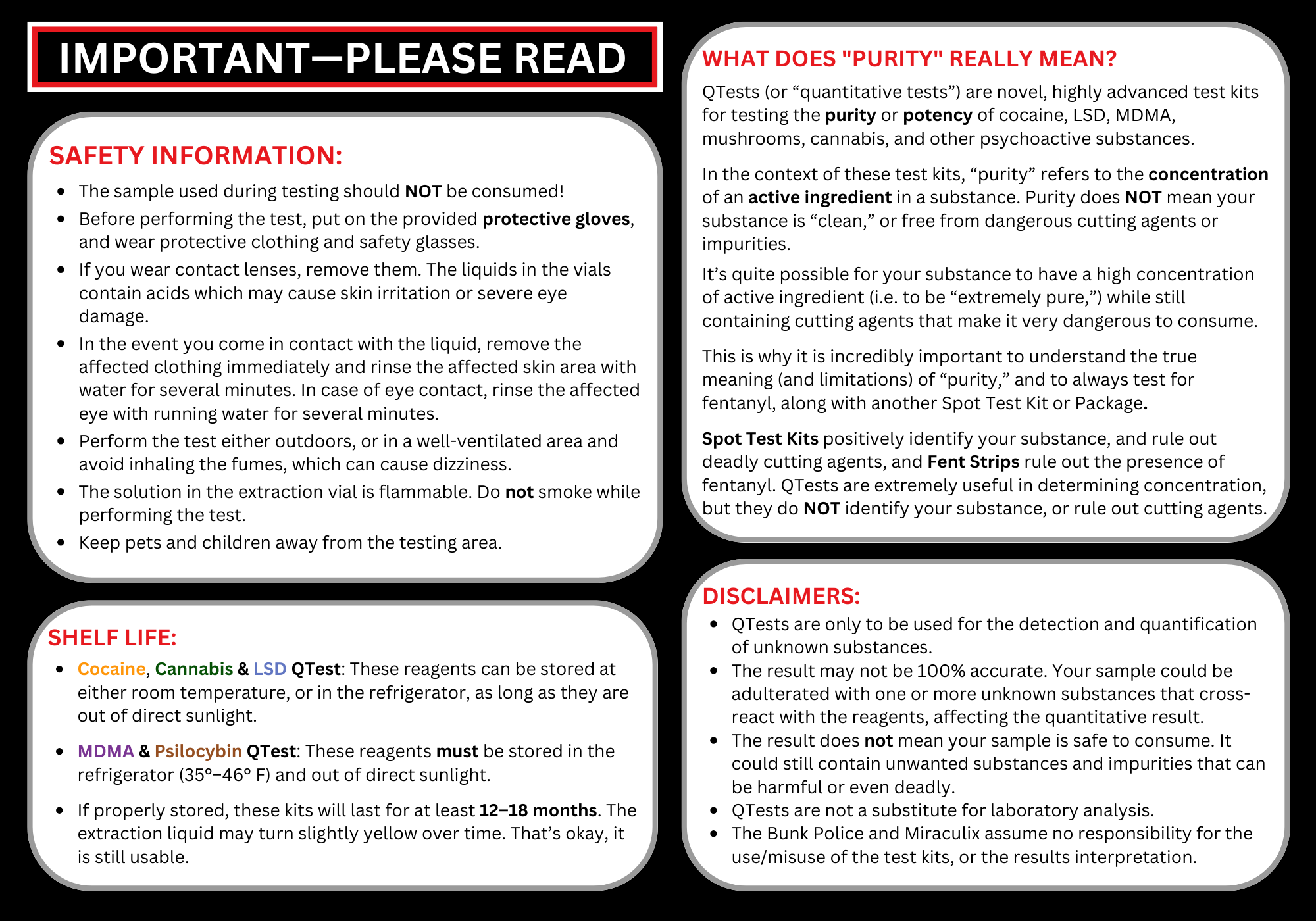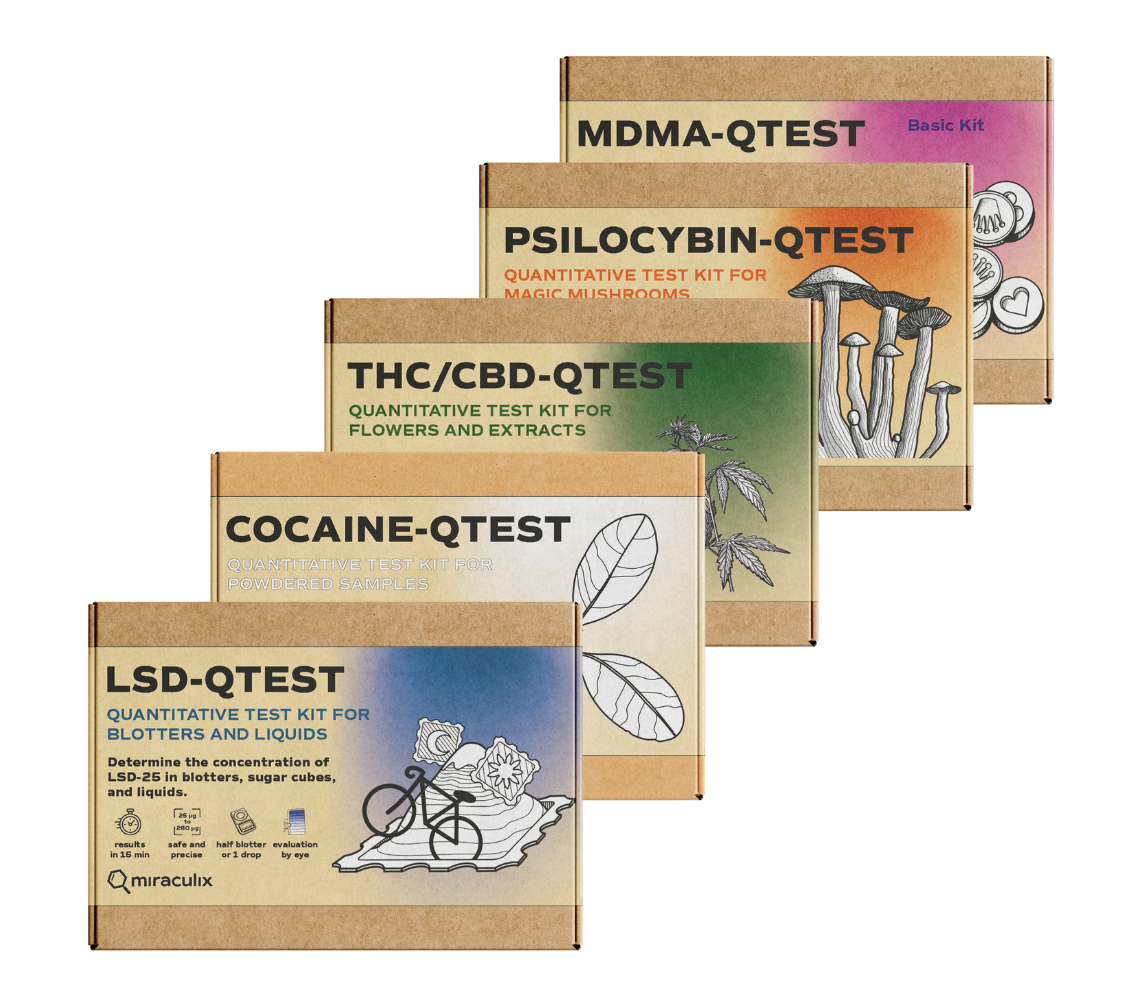QTest Purity Test Kit Basics
QTEST DRUG PURITY TEST KIT BASICS
What is a purity test?
QTests (or “quantitative tests”) are novel, highly advanced test kits for testing the purity or potency—the concentration of active ingredient—of cocaine, mushrooms, LSD, MDMA, and other psychoactive substances.
With these test kits, you can determine the number of grams of cocaine in powder or solid form, the milligrams of MDMA in powder, crystal, or tablet form, the micrograms of LSD in liquid or blotter, and the concentration of psilocybin or THC/CBD in mushrooms and cannabis material.

LSD QTEST INSTRUCTIONS
MDMA QTEST INSTRUCTIONS
COCAINE QTEST INSTRUCTIONS
PSILOCYBIN QTEST INSTRUCTIONS
CANNABIS QTEST INSTRUCTIONS
QTEST FAQ
After testing with a QTest, the results indicate that my substance is extremely pure. If my substance is “pure,” does this mean it’s “clean” or safe?
Absolutely not. In the context of this kit, the word “purity” simply indicates the concentration of the active ingredient in your substance. It does NOT indicate that your substance is “clean,” or that it does not contain dangerous cutting agents.
For example, let’s say you’re testing MDMA using a QTest. Your results indicate that your substance has 28 mg of MDMA per 32 mg of powder you tested. This means your MDMA is about 88% pure. Sounds good, right?
The problem is, this does NOT indicate what that remaining percentage contains. Your substance could be 88% MDMA, 10% methamphetamine, and 2% fentanyl. This second substance could seriously alter your experience, and the third could be fatal.
This is why it is incredibly important to understand the true meaning (and limitations) of “purity,” and to always test for fentanyl, along with another Spot Test Kit or Package. Spot Test Kits positively identify your substance, and rule out deadly cutting agents—our QTests are extremely useful in determining a substance’s concentration, but they do not identify your substance. Similarly, Fent Strips are the only way to rule out the presence of fentanyl.
Why do I need to homogenize (chop/mix) my mushrooms or cannabis?
Because psilocybin is not naturally distributed evenly inside of mushrooms, one mushroom can have ten times more or less psilocybin than another mushroom from the same batch. Even within a single mushroom the concentration of psilocybin can vary greatly. Therefore, if you don’t homogenize your material first, the test result will not be accurate for all your remaining material.
Cannabis flower functions similarly. To ensure the THC and CBD are evenly distributed, your cannabis must be homogenized. This provides the most accurate results possible for both the tested substance, and the remaining material.
Should I homogenize (chop/mix) my entire stash of mushrooms before testing their potency?
You can homogenize as much material as you want (before weighing out your 150 mg to test with) and this will tell you the potency of the entire batch of homogenized material. However, keep in mind that ground up mushrooms will degrade more quickly than whole mushrooms. Keeping them completely dry, sealed, and frozen (“freeze-dried”) will preserve the alkaloids best.
What’s the difference between a QTest Purity Test Kit and a Separation Test Kit?
QTests determine the concentration of a specific active ingredient (drug) in your sample. They provide a milligram amount or percentage amount to measure the purity or potency of your substance.
Separation Test Kits separate out and identify the substance(s) in a sample, allowing you to verify your substance, and check for potential cutting agents.
QTests do NOT identify your substance, and in certain cases (like with the MDMA QTest) it will react similarly with other non-MDMA substances. This is why it is incredibly important to verify your sample with a Spot Test Kit, or Separation Test Kit, before testing it for its concentration.
Does the Cannabis QTest work with THCA?
Yes, our Cannabis QTest works with THCA in flower/bud form. If you are trying to test a THCA extract, it will not work.



